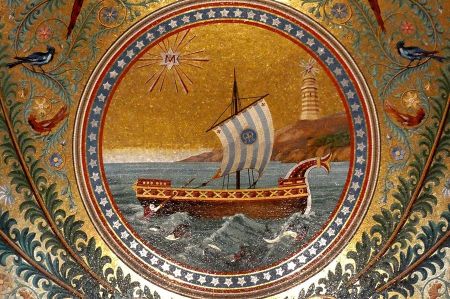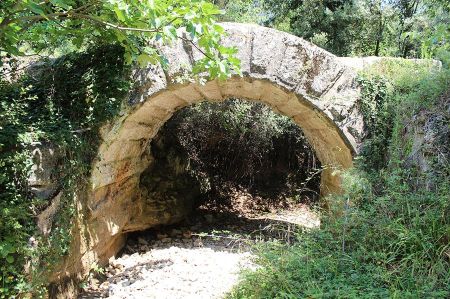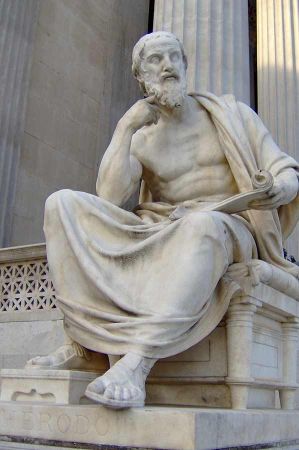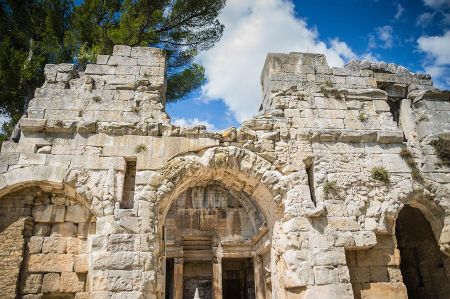Legends and founding myth about the city of Marseilles
- Written by Portal Editor
As already mentioned in our article “Short visit to the Tara”, we came to Marseille in Provence for a few days as part of our project work along the Roman roads in order to get to know the city in detail but also primarily to explore whether and which one ancient heritage is still visibly present in the city.
This is especially true given the fact that settlers once came from Asia Minor and settled here long before the Ottoman Empire or even Turkey came into being.
Sea traders come looking for trading places
 It was initially Greek sea traders from Phocaia in Asia Minor, today's Foca in Turkey, who regularly visited the southern coast of southern France near the mouth of the Rhone in the 7th century BC in order to conduct intensive trade with the Ligurian tribes living here. Tin in particular, as an ingredient in bronze extraction, was in great demand among the Greeks. In return, fine pottery and jewellery found their way into the homes of local princes. Protected landing places were rare on the rugged and rocky coast of southern France, so people often headed for the natural harbour in the bay of today's Marseilles, where the galleys were protected from wind and waves.
It was initially Greek sea traders from Phocaia in Asia Minor, today's Foca in Turkey, who regularly visited the southern coast of southern France near the mouth of the Rhone in the 7th century BC in order to conduct intensive trade with the Ligurian tribes living here. Tin in particular, as an ingredient in bronze extraction, was in great demand among the Greeks. In return, fine pottery and jewellery found their way into the homes of local princes. Protected landing places were rare on the rugged and rocky coast of southern France, so people often headed for the natural harbour in the bay of today's Marseilles, where the galleys were protected from wind and waves.
Around 620 to 600 BC In the 4th century BC, thanks to various land donations from the Ligurian princes, Greeks founded a permanently inhabited settlement at the then natural harbour, which the Greeks called Apoikie and subsequently called it Massalia. An emerging apoikia of antiquity is the settlement of a group of colonists that is located outside the area of the mother city (metropolis). Some of these settlers were sent out from their mother city to found a plant town or daughter town as emigrants. The head of such a company was usually a leader, often named by the mother city, called Oikistes. Such communities emerged primarily during the “great Greek colonization” between 750 and 550 BC. An Apoikia was fundamentally independent of the mother city and an independent polis that could also found new Apoikia itself, but remained relatively closely linked to it - especially when it came to cult, political organization and internal order. Examples of this include similar symbols on the coins of the Apoikiai and their mother cities.
Massalia grows through trade in the Mediterranean
 The Polis Massalia soon grew into one of the richest and largest Greek apoecias in the western Mediterranean, which, with its connection to the natural trade route of the Rhone, had cultural influence far into the hinterland. Evidence of this influence is the use of Greek letters by the Helvetii during Caesar's time. According to some researchers, a Greek influence may also have been preserved in some southern French dialects.
The Polis Massalia soon grew into one of the richest and largest Greek apoecias in the western Mediterranean, which, with its connection to the natural trade route of the Rhone, had cultural influence far into the hinterland. Evidence of this influence is the use of Greek letters by the Helvetii during Caesar's time. According to some researchers, a Greek influence may also have been preserved in some southern French dialects.
Málaga, Corsica and Nice were also settled by Greeks from Phocaia, who founded one apoikie after another. Over time, Massalia became so large and important that it itself sent settlers to found trading posts and cities in the west as far as Spain. The expansion of the Phocaians and Massaliots was brought to an end by a coalition of Etruscans and Carthaginians in the naval battle of Alalia.
New immigrants through the Persian conquests in Asia Minor
 Around the year 545 B.C. According to Herodotus, immigrants from Phocaia came to the city again in the 4th century BC. They fled after Harpagos, general of King Cyrus II of Persia, conquered Phocaia. In any case, it can be considered historically certain that a man named Harpagos became one of his military commanders after Cyrus II came to power. He took part in the battle of the Persian king against the Lydians and, according to Herodotus, through his stratagem that horses did not like the smell of camels, was able to drive away the Lydian cavalry and thus reach the encirclement of Sardis, the capital of Croesus, which was captured two weeks later 541 B.C. BC was taken. Later, as Mazares' successor, he led campaigns against the rebellious Greeks of Asia Minor (initially led by Paktyes). He then first took Smyrna (today's Izmir) and the seaside city of Phokaia and finally subjugated all Ionians on the mainland for Cyrus. This was followed by the conquest of Caria and Lycia. The independent Miletus was spared. To capture the cities of the Ionians, he used catapults for the first time in history; This is proven at least for his conquest of Phocaia. Descendants of Harpagos probably also held high offices in Asia Minor.
Around the year 545 B.C. According to Herodotus, immigrants from Phocaia came to the city again in the 4th century BC. They fled after Harpagos, general of King Cyrus II of Persia, conquered Phocaia. In any case, it can be considered historically certain that a man named Harpagos became one of his military commanders after Cyrus II came to power. He took part in the battle of the Persian king against the Lydians and, according to Herodotus, through his stratagem that horses did not like the smell of camels, was able to drive away the Lydian cavalry and thus reach the encirclement of Sardis, the capital of Croesus, which was captured two weeks later 541 B.C. BC was taken. Later, as Mazares' successor, he led campaigns against the rebellious Greeks of Asia Minor (initially led by Paktyes). He then first took Smyrna (today's Izmir) and the seaside city of Phokaia and finally subjugated all Ionians on the mainland for Cyrus. This was followed by the conquest of Caria and Lycia. The independent Miletus was spared. To capture the cities of the Ionians, he used catapults for the first time in history; This is proven at least for his conquest of Phocaia. Descendants of Harpagos probably also held high offices in Asia Minor.
Conflicts with the Celts around Massalia
 However, there were increasing conflicts around Massalia with the Celtic tribes, who now dominated almost all of Gaul. In 125 BC, Massalia called on the troops of the Roman Empire for help against the attacks of Gallic tribes (Ligurians, Allobrogi, Salluvi, Arverni and Vokontii). During the course of the war, the entire area of southern Gaul was annexed by the Romans as the province of Gallia Narbonensis. However, the city itself initially remained an ally of Rome and was able to maintain its independence for several decades. During the years of civil war between Julius Caesar and Gnaeus Pompeius, Massalia wanted to remain neutral, but this was not tolerated by Caesar. In 49 B.C. The city was finally conquered after a six-month siege in 500 BC and was soon integrated into the province of Narbonensis. It remained part of the Roman Empire until the end and gradually lost its Greek character.
However, there were increasing conflicts around Massalia with the Celtic tribes, who now dominated almost all of Gaul. In 125 BC, Massalia called on the troops of the Roman Empire for help against the attacks of Gallic tribes (Ligurians, Allobrogi, Salluvi, Arverni and Vokontii). During the course of the war, the entire area of southern Gaul was annexed by the Romans as the province of Gallia Narbonensis. However, the city itself initially remained an ally of Rome and was able to maintain its independence for several decades. During the years of civil war between Julius Caesar and Gnaeus Pompeius, Massalia wanted to remain neutral, but this was not tolerated by Caesar. In 49 B.C. The city was finally conquered after a six-month siege in 500 BC and was soon integrated into the province of Narbonensis. It remained part of the Roman Empire until the end and gradually lost its Greek character.
New Roman province of Gallia Narbonensis
 Gallia Narbonensis is the new name of the province Gallia transalpina, which was renamed in 27 BC and which was established as a Roman province between 125 and 118 BC. Its designation as a province meant that part of the landscape is still called Provence today.
Gallia Narbonensis is the new name of the province Gallia transalpina, which was renamed in 27 BC and which was established as a Roman province between 125 and 118 BC. Its designation as a province meant that part of the landscape is still called Provence today.
As consul in 125 BC. In 400 BC Marcus Fulvius Flaccus was commissioned by the Senate to support Massalia against the Salluvii's plundering. Flaccus used this mission to conquer large parts of the country, which is why he was honoured with a triumphal procession on his return to Rome (123 BC). The capital was initially in 120 BC. The fortress of Aquae Sextiae (Aix-en-Provence) was built in the 1st century BC, and later the 118 BC. The first citizens' colony, Colonia Narbo Martius (Narbonne), was founded in the 1st century BC.
 In 121 B.C. In the 4th century BC, what was then Gaul finally became a province of the Roman Empire. Throughout Provence you can still find numerous, sometimes very important, remains of Roman culture; many cities were founded back then or were expanded by the Romans. Hardly, however, in Marseille, where the Roman period appears almost exclusively through fragments of exhibitions in museums. Important monuments and buildings from the Roman period can be found today, for example. B. in Arles (Roman: Arelate), Fréjus (Forum Julii), Nîmes (Nemausus), Orange (Arausio), near Saint-Rémy-de-Provence (Glanum) or in Vaison-la-Romaine (Vasio Vocontiorum). But cities like Aix-en-Provence (Aquae Sextiae) and Avignon (Avenio Cavarum) also existed in Roman times. Also impressive is the very well-preserved aqueduct Pont du Gard, which was part of the water supply of Nîmes, or the Roman victory monument Tropaeum Alpium in La Turbie in an impressive location high above the Mediterranean coast. So, if you want to spend a holiday in the footsteps of the Romans, then you will certainly not be disappointed in Provence.
In 121 B.C. In the 4th century BC, what was then Gaul finally became a province of the Roman Empire. Throughout Provence you can still find numerous, sometimes very important, remains of Roman culture; many cities were founded back then or were expanded by the Romans. Hardly, however, in Marseille, where the Roman period appears almost exclusively through fragments of exhibitions in museums. Important monuments and buildings from the Roman period can be found today, for example. B. in Arles (Roman: Arelate), Fréjus (Forum Julii), Nîmes (Nemausus), Orange (Arausio), near Saint-Rémy-de-Provence (Glanum) or in Vaison-la-Romaine (Vasio Vocontiorum). But cities like Aix-en-Provence (Aquae Sextiae) and Avignon (Avenio Cavarum) also existed in Roman times. Also impressive is the very well-preserved aqueduct Pont du Gard, which was part of the water supply of Nîmes, or the Roman victory monument Tropaeum Alpium in La Turbie in an impressive location high above the Mediterranean coast. So, if you want to spend a holiday in the footsteps of the Romans, then you will certainly not be disappointed in Provence.
In 314, the first known bishop of Massilia, Oresius, is mentioned in the document of the Council of Arelate. At the beginning of the 5th century AD, the monastery of Saint-Victor was founded on the south bank of the Old Port, which was to be the residence of the bishops of Marseille from 750 to 960. In 481 the city fell to the Visigoths, in 508 to the Ostrogoths, and in 536 to the Franks.
Founding myth or legend of the city of Massalia
 According to the ancient founding myth, the city was created when Greek sailors from Phokaia, today's Foca in Turkey, explored the Mediterranean coast in search of trading places. They landed on the coast of what is now Marseille on the day that a Celtic king named Nann was looking for a husband for his daughter Gyptis.
According to the ancient founding myth, the city was created when Greek sailors from Phokaia, today's Foca in Turkey, explored the Mediterranean coast in search of trading places. They landed on the coast of what is now Marseille on the day that a Celtic king named Nann was looking for a husband for his daughter Gyptis.
Gyptis was to give a cup to the one she wished to marry from among all the young men gathered. Surprisingly, it was Protis, the leader of the newcomers, to whom she gave the vessel. The two married, and Greeks and Celts founded the settlement of Massalia together.
Please read as well:
